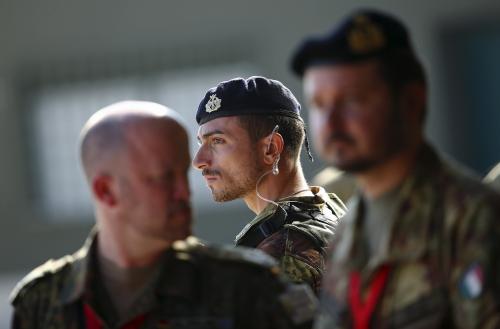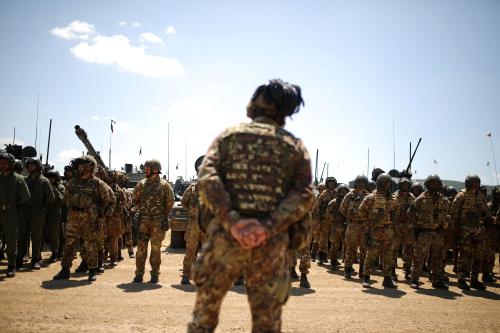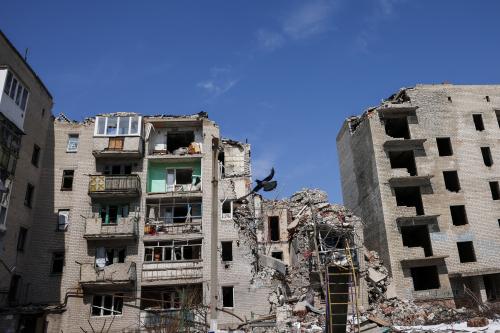Presidents George Bush and Vladimir Putin signaled at their Shanghai summit that they are working on a deal to trade U.S. willingness to make deep cuts in offensive nuclear weapons for Russia’s willingness to relax restrictions on developing missile defenses.
But while the two men had encouraging things to say, substantial differences still separate them.
There are two outstanding issues. The first is how deep to cut nuclear weapons stockpiles. Both sides possess about 7,000 warheads. The START II Treaty mandates reductions to 3,000 to 3,500 warheads each by 2007. In 1997, former Presidents Bill Clinton and Boris Yeltsin agreed that a START III accord would go down to 2,000 to 2,500 warheads.
Strapped for cash, Moscow now wants to go below 1,500 warheads. Mr. Bush has never said how low he is willing to go. His administration is still working on the strategic review it began in January to settle the issue.
Some senior uniformed officers in the U.S. Strategic Command strongly oppose going below the Clinton-Yeltsin numbers. But senior administration aides say privately that Mr. Bush, who has long advocated the need to break out of Cold War thinking, may be willing to go part way in Moscow’s direction. Unlike Mr. Clinton, he has the political credibility to override Pentagon opposition.
So the gap on the offensive side probably can be bridged. The harder nut to crack will be the second issue in dispute: the status of the Anti-Ballistic Missile (ABM) Treaty. Mr. Bush has said he wants out of a treaty he sees as dangerous and obsolete. In its place, he offers Moscow an ill-defined and nonbinding “strategic framework.” But will Mr. Putin settle for just a handshake, even one accompanied by a signed statement of principles that is legally binding on neither party?
Mr. Bush argues that the ABM Treaty no longer makes sense because the United States faces dangerous and unpredictable threats. The way to maximize America’s security in such an uncertain world is to minimize the constraints on its freedom to act.
Sept. 11 gave Mr. Putin leverage he didn’t have before—Russian cooperation in the Bush administration’s war against terrorism. Moscow has supported the United States at the U.N. Security Council, shared its intelligence information on al-Qaida and facilitated rather than hindered the movement of U.S. troops to Central Asia. That cooperation will be critical in defeating terrorists in the years to come.
Nor does Mr. Putin have much flexibility politically back home. His critics complain that, like Mikhail Gorbachev and Mr. Yeltsin before him, he is too willing to defer to Washington’s wishes. Russian military leaders grumble that he has gotten nothing in return for his concessions in assisting Mr. Bush’s military effort.
In this context, it is hard to imagine that Mr. Putin could afford to abandon the ABM Treaty even if he wanted to.
Moscow’s cooperation could be lost if the administration overplays its hand on the ABM Treaty. But there is a way out of this dilemma. It is to de-link the question of a robust U.S. research and development program on missile defense from the longer-term question of the ABM Treaty’s future.
With such an approach, which Moscow and Washington appear to be considering, the administration would get what it says it wants—much greater flexibility to investigate which missile defense technologies will work.
In return, the United States would give up, at least for now, it insistence on abandoning the ABM Treaty.
A compromise along these lines would require Mr. Bush to face down those within his administration and party who revile the ABM Treaty so much that they would pay almost any price to see it gone.
But the goal of a sensible missile defense policy should not be not to tear up treaties.
It should be to maximize American security. And a deal that sharply cuts nuclear weapons stockpiles, resolves U.S.-Russian differences over the ABM Treaty for the time being and keeps Russia firmly involved in the international anti-terror coalition would do just that.



Commentary
Op-edTest ABMs, But Keep Treaty Intact
October 26, 2001